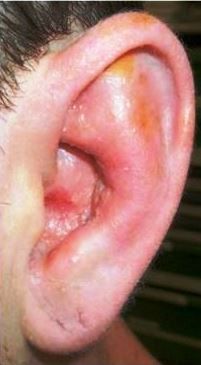- CDC
- Heart Failure
- Cardiovascular Clinical Consult
- Adult Immunization
- Hepatic Disease
- Rare Disorders
- Pediatric Immunization
- Implementing The Topcon Ocular Telehealth Platform
- Weight Management
- Screening
- Monkeypox
- Guidelines
- Men's Health
- Psychiatry
- Allergy
- Nutrition
- Women's Health
- Cardiology
- Substance Use
- Pediatrics
- Kidney Disease
- Genetics
- Complimentary & Alternative Medicine
- Dermatology
- Endocrinology
- Oral Medicine
- Otorhinolaryngologic Diseases
- Pain
- Gastrointestinal Disorders
- Geriatrics
- Infection
- Musculoskeletal Disorders
- Obesity
- Rheumatology
- Technology
- Cancer
- Nephrology
- Anemia
- Neurology
- Pulmonology
B. Ramsay Hunt Syndrome – This not the correct answer
Ramsay Hunt syndrome (Herpes zoster oticus) classically features the triad of ipsilateral facial paralysis, ear pain, and vesicles in the auditory canal and auricle (Figure).

Image courtesy of Brady Pregerson, MD
Ramsay Hunt syndrome (Herpes zoster oticus) classically features the triad of ipsilateral facial paralysis, ear pain, and vesicles in the auditory canal and auricle (Figure). This constellation of symptoms is the result of reactivation of the varicella zoster virus from the facial nerve root ganglion (geniculate ganglion).
The facial paralysis component of Ramsay Hunt Syndrome is specific to the facial nerve involvement. In this case, the patient’s initial presentation of ear pain, which was originally misdiagnosed as otitis media, was a painful varicella zoster lesion in the ear canal, which put Ramsay Hunt syndrome in the differential. The distribution of the rash fits both the trigeminal and facial nerve distribution, but the lack of facial nerve paralysis makes this diagnosis unlikely. Taste perception, hearing (tinnitus, hyperacusis), and lacrimation can also be affected in select patients with Ramsay Hunt Syndrome, which is generally considered a polycranial neuropathy with frequent involvement of cranial nerves V, IX, and X.
To return to the case, please click here.
